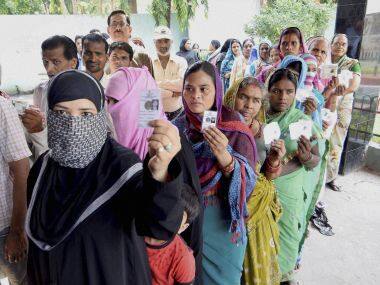By Sanjay Kumar The 49 assembly constituencies in Bihar, which went to polls on 12 October, witnessed 57 percent turnout. This is seven percent higher compared to the 2010 assembly elections. More importantly, the turnout of women voters (59 percent) was higher compared to that of men (54 percent). This is complete reversal of the trend of the elections held in the in the past when men used to vote in much bigger numbers compared to women. The trend of voting turnout in Bihar has changed since the 2010 assembly elections. During those elections women voters surpassed men across the state. The 2014 Lok Sabha election also witnessed a similar trend. It raises two questions – A) what has resulted in this change? B) does this benefit any particular political party? [caption id=“attachment_2467008” align=“alignleft” width=“380”]
 Voters line up at Begusarai to cast their vote on Monday. PTI[/caption] While there can’t be a definite answer to these questions, there are pointers to why women are voting in much bigger numbers compared to the past. First, with 50 percent reservation at the panchayat level women have become more politically active. Though reservation for women in panchayat bodies have been in place for some time, it took some years for women voters to realize that they matter in politics and they can play an active role in it. The second explanation to support such turnout is the increasing trend among women to take independent decision while voting. Surveys conducted by Centre for the Study of Developing Societies (CSDS) indicate this. In the 2010 Bihar assembly elections, when women respondents were asked if they consulted someone before voting, 45 percent said they did, 50 percent said they did not and 5 percent did not express their opinion. Even among the 45 percent who consulted someone, nearly half (46 percent) said they ultimately voted on their own without getting influenced by the advice. Moreover, recent survey evidence suggests that women voters in Bihar have begun making electoral choices different from men. The voting in the first phase goes on to reinforce the trend. But this hardly affect positively or negatively the chances of any political party or alliance. While women voters may be large in numbers they do not form a vote bank. Their vote remains divided between the two alliances. Male voters tend to get polarized more. Some women prefer to vote for independent candidates and even for candidates from smaller political parties. Sanjay Kumar is a Professor and currently the Director of the Centre for the Study of Developing Societies.
Voters line up at Begusarai to cast their vote on Monday. PTI[/caption] While there can’t be a definite answer to these questions, there are pointers to why women are voting in much bigger numbers compared to the past. First, with 50 percent reservation at the panchayat level women have become more politically active. Though reservation for women in panchayat bodies have been in place for some time, it took some years for women voters to realize that they matter in politics and they can play an active role in it. The second explanation to support such turnout is the increasing trend among women to take independent decision while voting. Surveys conducted by Centre for the Study of Developing Societies (CSDS) indicate this. In the 2010 Bihar assembly elections, when women respondents were asked if they consulted someone before voting, 45 percent said they did, 50 percent said they did not and 5 percent did not express their opinion. Even among the 45 percent who consulted someone, nearly half (46 percent) said they ultimately voted on their own without getting influenced by the advice. Moreover, recent survey evidence suggests that women voters in Bihar have begun making electoral choices different from men. The voting in the first phase goes on to reinforce the trend. But this hardly affect positively or negatively the chances of any political party or alliance. While women voters may be large in numbers they do not form a vote bank. Their vote remains divided between the two alliances. Male voters tend to get polarized more. Some women prefer to vote for independent candidates and even for candidates from smaller political parties. Sanjay Kumar is a Professor and currently the Director of the Centre for the Study of Developing Societies.
Reservation and empowerment: Here's why women are flocking to Bihar's polling booths
FP Archives
• October 13, 2015, 15:51:02 IST
The trend of voting turnout in Bihar has changed since the 2010 assembly elections. During those elections women voters surpassed men across the state.
Advertisement
)